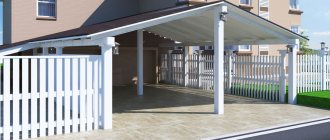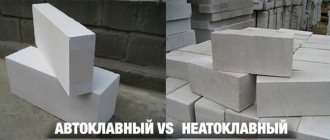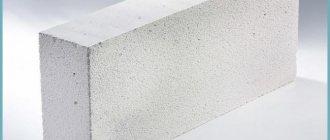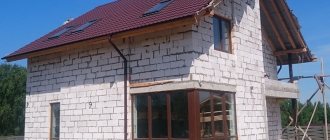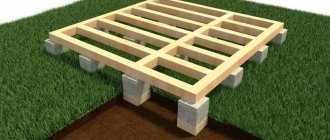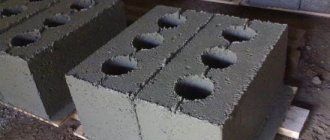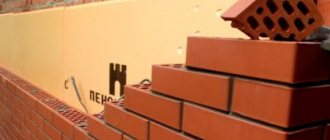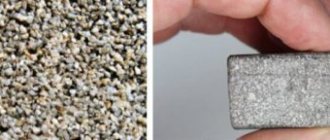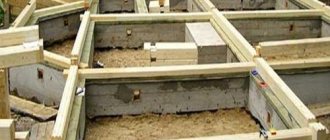Aerated concrete blocks are often used for the construction of houses, sheds, garages and other buildings.
Like any other material, it has its defenders and ardent haters. The advantages and disadvantages of the material cause a lot of controversy among developers.
The article describes all the pros and cons of building houses from aerated concrete blocks, based on which you will be able to make the right choice.
Advantages
The following advantages of buildings made of aerated concrete blocks can be highlighted::
- Low price of building material. The final cost of building from aerated blocks will be lower than from brick, timber or expanded clay concrete.
- Light weight of the material, which reduces the load on the foundation.
- Ease of processing. Aerated concrete blocks can be easily sawed, cut and sanded. To perform these operations, narrow-profile equipment is not required. All manipulations can be performed with a hacksaw or a classic grinder.
- High speed of construction.
- Environmental friendliness of gas blocks. In the process of their manufacture, sand, ash, slag, cement, quicklime, water and aluminum paste are used. The material’s own radioactive background does not exceed 54 Bq/g and is within the limits specified in GOST 30108-94 (the maximum permissible value is 370 Bg/g). For comparison, the radioactive background values of bricks are 120 Bg/g.
- Possibility of use for different purposes. Not only houses are built from aerated concrete blocks, but also garages, bathhouses, fences, fences, sheds, etc. The wide geometry makes it possible to build arches and other complex structures from them.
- Low thermal conductivity, thanks to which an aerated concrete house will always be warm. This will allow owners of such housing to significantly save on heating costs.
- High frost resistance. A high-quality gas block can withstand 50 freezing and thawing cycles and even more.
- Compatibility with any type of finishing material.
- Possibility of choosing aerated concrete blocks with different strength indicators. There is material for sale for the construction of one- and two-story houses.
- Fire resistance. The gas block does not burn in a fire and does not support the fire. It does not emit harmful substances, which reduces the risk of poisoning by combustion products. The material can remain on fire for up to 3 hours. During this time, it will not lose its technical properties.
- Good sound insulation. The porous structure of the material perfectly absorbs noise.
- Long service life - up to 200 years. Under normal operating conditions, the masonry does not deform.
Gas block is a “breathable” material. This means that if all construction technologies are followed, the greenhouse effect will not occur in the room , and fungus and mold will not appear.
The blocks will independently remove steam and moisture outside.
Disposal of blocks is accompanied by their slow decomposition . Decay products released into the soil or water bodies will not cause harm to the environment.
Advice ! To fully appreciate the benefits of aerated concrete blocks, you need to purchase only certified products.
Advantages of aerated concrete houses
Advantages of gas blocks:
1. relatively low price;
2. savings on heating costs, houses made of aerated blocks require less energy for heating in the winter;
3. low load on the foundation, but high strength is required to prevent shrinkage;
4. optimal “strength-lightness” ratio for individual construction of houses, outbuildings, baths;
5. one person can lay out the walls from aerated concrete;
6. convenient transportation due to the low weight of the blocks;
7. minimal background radiation;
8. the ability to make various bends, arched openings, stairs and other structures of any, including complex configurations;
9. good level of sound insulation;
10. ease of processing without the use of special equipment, aerated concrete blocks are easy to cut, saw, and grind with hand tools;
11. biological stability, fungi, mold, etc. do not appear on the surface;
12. vapor permeability, walls “breathe”;
13. fire resistance, aerated concrete does not support combustion, withstands temperatures up to +1200C, and during a fire it is almost not destroyed within 3 hours;
14. houses are easy to repair and rebuild.
You will find more features of gas blocks and reviews from developers in this article.
Disadvantages of buildings made of aerated blocks
Minuses:
1. unsuitability for multi-storey construction as the main material of load-bearing walls due to low compressive strength;
2. a house made of aerated concrete warms up quickly (in 2 hours from 0 to 20C), but just as quickly gives off heat in the absence of heating (by 1C per hour);
3. even with minor violations of technology when pouring the foundation, causing shrinkage, up to 20% of the blocks become covered with cracks, this does not lead to the destruction of the house, but has a bad effect on the appearance;
4. the foundation must be stable with respect to any ground movements, otherwise the problem of cracks will arise again;
5. aerated concrete masonry with glue must be done very well, otherwise the house will be “blown out”;
6. the material is hygroscopic, quickly absorbs moisture from the air, including during fog, which forces the walls to be finished immediately after completion of the masonry, and be sure to waterproof and insulate;
7. The gas block has low frost resistance - only up to 35 defrost-freeze cycles;
8. restrictions on finishing materials for facades;
9. before plastering, careful preparation of the walls is required, since their surface is too smooth, which results in a very low level of adhesion to any coating; it is necessary to use a special primer;
10. lime contained in aerated concrete and adhesive mixtures for it quickly renders any metal objects unusable, including communication pipes in contact with the blocks;
11. gas blocks do not hold well to any type of fasteners (under shelves, wall cabinets, etc.), special fasteners are required (for example, plastic butterfly dowels, anchors);
12. low burglary resistance, thieves can simply cut out a passage with a chainsaw, and the bars on the windows hold up worse than those of houses made of other materials.
When comparing the advantages and disadvantages of a house made of aerated concrete, you need to pay attention to the fact that most of the disadvantages are eliminated during the installation process. To do this, you just need to carefully follow the technology and take into account all the nuances.
Flaws
The disadvantages of aerated concrete blocks include:
- The need for mandatory finishing of aerated block walls. If the material absorbs water and it freezes, the likelihood of structural failure increases. Therefore, even for one winter, unfinished buildings need to be preserved. Damage to the structure can be caused not only by rain and snow, but also by fog.
- Smoothness of the walls. This factor complicates finishing, since mixtures do not adhere well to such a surface. To solve the problem, you have to resort to double priming or reinforcement with a polymer mesh.
- Poor fixation of fasteners. Any products that have a weight slightly higher than the minimum will not stick well to the walls. To securely fix cabinets, shelves or other elements, you will have to use special fasteners.
- The appearance of cracks in the wall due to incorrect calculation and installation of the base.
- Low strength and flexural compression.
When building houses with more than two storeys, aerated concrete blocks cannot be used to build load-bearing walls. In this case, they are only suitable for laying partitions.
What does density affect?
Density is the most important characteristic of this material. It is marked with the letter D, followed by a digital designation. Density is measured in kg/m³. Depending on the average density, different grades of aerated concrete are distinguished; in low-rise construction, the most popular are D300, D400, D500, D600.
For the construction of low-rise buildings, in most cases, aerated concrete grades D400 (density 400 kg/m³) and D500 (density 500 kg/m³) are used. By analogy with brick, many block buyers often think that the denser the blocks, the stronger and warmer they are - this is not true.
The density of aerated concrete is indirectly related to strength; it is directly related to thermal conductivity; The denser the block, the greater its thermal conductivity.
And the strength can be different even for blocks of the same density; this may also depend on the quality of the cement: the higher it is, the higher the class of concrete. Although in most cases, aerated concrete blocks with a density of D400 will be warmer than D500, but not as strong; and blocks with a density of D500 are stronger, but also colder than D400.
NadegniyForumHouse Member
Read the reports from forum members, where they talk about internal cracks inside the blocks, which sometimes reach 30-40% in a batch, and are revealed only during the finishing process. They take aerated concrete of the D600 brand for themselves, but for the customer, so as not to swear, they can take D500, and D300-D400 only for the enemy.
YuryFORUMHOUSE Member
It is better not to chase the thermal properties of the blocks, but to give preference to their strength (density). 100mm expanded polystyrene will solve all questions regarding thermal protection.
A wall made of aerated concrete must be strong and retain heat, and most often in our country, two- and three-story houses are built from blocks with a density of D400-D500, which provide the necessary thermal protection and rigidity of wall structures even when constructing heavy reinforced concrete floors. But still, people build houses from D300 or D350 blocks - from a number of manufacturers, if certain conditions are met, they are quite suitable for constructing load-bearing walls and do not require additional insulation.
timo5680170FORUMHOUSE member
Built from D300 with a thickness of 375, I live for 1.5 years. Everything is fine. In the calculation of heat loss, it was written to me: insulation above the standard may not be justified.
Owner reviews
Since houses have been built from aerated concrete blocks for several decades, people have managed to accumulate a lot of experience in using them and form a definite opinion about living in buildings made from this material.
Positive points that can be extracted from reviews:
- Lightweight masonry material. A person with no experience in construction can build a house from aerated concrete blocks.
- There is no need to invest a significant amount of money on home insulation. Such rooms are warm in winter and cool in summer.
- Opportunity to save on heating costs in winter.
- Possibility of erecting any building whose height does not exceed two floors.
In addition to the advantages, people highlight the following disadvantages:
- Spending on finishing to ensure high-quality waterproofing of the house. If this is not done, the water will destroy the building.
- Difficulties with decorative finishing, the need to use special glue, primer and plaster.
- The need for wall reinforcement. Every fourth row of blocks needs strengthening, otherwise cracks will appear in the walls.
- The absorption of moisture by the blocks causes the reinforcement inside to rot, which negatively affects the strength of the walls.
You can read user reviews at the following links here, here, here and here.
Reviews
Anton Makarchuk 3 years ago they built a dacha. A friend advised me to make the masonry not from brick, but from gas silicate blocks. At first I thought about the fact that it was very cheap, I figured that I would have to spend a lot of money on insulation, since we planned to use the dacha all year round. But then I finally decided. And I was pleased. They built it themselves, but despite this, construction progressed very quickly, several rows were laid per day. Thanks to the glue, I didn’t have to bother with mixing solutions. The whole family was satisfied; in winter the temperature does not drop below 22 degrees, although we do not heat much.
Rudnev Nikolay We built a house from gas silicate blocks this summer. There were 5 of us. Along with laying the foundation, the construction (120 square meters house) took a little over 2 weeks, not taking into account finishing, etc. I was pleasantly surprised by the low price. Clear shapes and angles do not require additional time to match and draw angles. It looks very decent even without exterior decoration. The only difficulties we encountered were with the interior decoration. The surface was very smooth and the putty did not adhere well, so I had to invest in a large amount of painting mesh.
Yuri Guzenko A friend built a house from this material 4 years ago. I have never heard particularly flattering reviews from him about heat saving. And cracks have already begun to appear...
Vladimir Aleksandrovich This is the third winter we will have to live in a house made of gas silicate. They laid it on glue, the construction did not cause any special difficulties or additional costs. There are no cracks anywhere, although this probably depends on the glue, since a neighbor laid it on the mortar a year before me and already received several cracked blocks. It’s still worth putting it on glue.
Gennady Last summer we built a house. The store advised me to choose gas silicate blocks for the walls rather than brick. They said that such a house does not need to be insulated and it will keep warm well in winter. We carried out finishing work in the fall and encountered our first unpleasant surprise - driving a nail into such a wall was simply a nightmare. I even had to attach the plumb line to dowels, because the nail was flying out, as if the plumb line weighed too much.
Then winter began and the second drawback of this material surfaced - it does not retain heat as much as the sellers say. He's very cold. It turned out that it was necessary to make masonry from several types of blocks, use structural ones on the outside, and lay heat-insulating ones in the second row, inside the house. But this is very expensive, especially since the work inside the house has already been completed. In the summer you will have to spend money on insulation.
A competent approach to block selection
Let's consider several brands of aerated concrete that are used in low-rise construction.
D300, strength class B1.5-B2 . Maximum compressive strength 22.13-29.57 kg/cm². Frost resistance grade F25 (withstands 25 freeze-thaw cycles). Such blocks have high thermal insulation properties: the heat transfer resistance of a 30 cm wall is 3.38 W/m °C. The very high porosity of blocks of this brand (more than 80%) allows the structure to perfectly absorb sound (up to 52 dB). These blocks are lighter and easier to work with.
D400, strength class B2-B2.5. Maximum strength of 29.57 -36.91 kg/cm². Withstands 35 freeze-thaw cycles. Such blocks are 75% porous, that is, they are quite durable and warm at the same time (the thermal conductivity resistance of the wall is 2.8 W/m °C). There is even a formula for a good wall made of aerated blocks, 400x400: thickness 400 mm, density D400. A wall of these ten-centimeter-thick blocks absorbs 35-37 dB.
D500, strength class B2.5-3.5 , compressive strength 25-46 kg/cm², porosity 65-75%. The thermal conductivity resistance of a wall made of such blocks is 2.1 W/m °C. Frost resistance - F50. A wall 12.5 cm thick has a noise absorption coefficient of 44-46 dB.
D600 – strength class B3.5-5 . An 18 cm wall absorbs sound of 43 dB. You don’t even need to consider how thick houses made of such aerated concrete should be so that they don’t get cold in winter - this would be irrational, they need additional insulation.
A member of our portal with the nickname Negativ, who professionally works with aerated concrete, explained how to correctly select blocks for a project.
- Find in the project what strength is needed;
- Select the minimum possible density from all possible options for the aerated concrete block. If B2.0 turns out to be sufficient, this means that D400 B2.0 blocks will be optimal. And for a one-story house, B1.5 may be suitable.
Compressive strength: what should a wall made of aerated concrete be like?
The structure and appearance of aerated concrete blocks raise doubts about its strength. It seems that a material that is more than half air bubbles must be brittle. But in reality, blocks perfectly resist the process of tension, and numerous experiments have proven their compressive strength. The strength of the blocks is explained by the thick walls - the load of the house is evenly distributed over them. Horizontal masonry increases the durability of the house.
What determines the strength of aerated concrete:
- on the quality of the raw materials from which the blocks are made - their ability to absorb moisture is especially important here. The higher it is (and the higher the water-cement ratio), the lower the strength of the block;
- from the uniformity of the structure - in blocks with an uneven structure the core gradually collapses;
- on volumetric weight - the strength of the blocks can vary depending on their height.
GOST 10180 and GOST R53231 impose requirements on the strength classes of aerated concrete. Compressive strength is indicated by the letter B, and the numbers after it show how much load a square millimeter of aerated concrete can withstand. Thus, strength class B2.0 means that aerated concrete can withstand 20 kg per 1 cm2. You can calculate what load one gas block with parameters 60 x 30 cm can withstand: 1800 sq.cm x 20 kg = 36,000 kg. Or the load that one linear meter of aerated concrete can withstand: 100 cm x 30 cm x 20 kg = 60 tons.
In reality, responsible manufacturers do not establish the exact compressive strength overall for the product, but determine it in laboratories: a press presses on samples of aerated concrete until cracks appear on it, and then the actual indicators are recorded in the certificate.
Negativ FORUMHOUSE Member
Block strength is a routine test; along with density testing, it is performed for each specific batch.
Each batch of aerated concrete blocks at the plant is marked and stacked separately; and if the company declares blocks with different combinations of density and strength, then you need to clarify whether the combination you are interested in is available at the time of shipment.
The design resistance of aerated concrete masonry is determined by building standards: they include various factors that reduce the strength of the structure. According to SNiP, a safety margin is created: thus, the calculated resistance of masonry made from blocks with strength class B 2.5 is 1.0 MPa or 10 kg/cm2. This is 2.5 times less than the strength of the blocks themselves, and a linear meter of masonry 30 cm thick will withstand a load of 30 tons.
Manufacturers recommend building houses up to three floors from aerated blocks. The strength of blocks is:
- B2.0 - you can build one-story buildings;
- B2.5 - corresponds with a margin to a one-story house and a two-story house with floor slabs, but for a two-story house with monolithic floors it is no longer recommended;
- B3.5 and above - suitable for building three-story houses.
When choosing strength, you need to understand that the structure may not be executed perfectly correctly, and then what?
Zheka888FORUMHOUSE Member
I am not 100% confident in the builders, so for the attic house I choose a strength between B2.5 and B3.5. I don’t consider B1.5 at all.
When there is a choice between thermal efficiency and strength, it is better to sacrifice thermal efficiency: who will need it if cracks appear along the wall?
